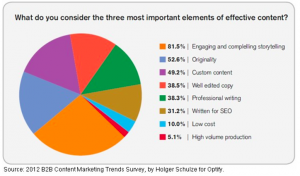Five trade show mistakes to avoid
December 13, 2012
 Mistake #1: Not having a pre-game plan.
Mistake #1: Not having a pre-game plan.
Trade shows are one of those things that sneak up on you. You’re going to have to be out of the office for a few days, you need everything shipped in advance and you’re juggling your regular work. But the prep work should be done months in advance, which you can still take action on the ideas you think will give you the bang for your buck.
You should have an action plan for pre show, the show itself and post show. Most people put some thought into the actual event but rarely do anything in advance to get attendees to their booth. You can do something traditional like an attendee bag insert or you could get creative and do something in the lobby of the hotel most attendees will be staying at. But do something.
Mistake #2: Pretty pictures are a dime a dozen
Yes, a spectacular booth is eye-catching and can sometimes draw a crowd. But these days, those are table stakes. Most companies have a visually appealing booth filled with pretty pictures. You want the attendees to know, at a glance, what you do and why they should care.
Keep these tips in mind. Show me before and after shots. One or two huge visuals are more effective than a montage or lots of smaller shots. If you can do a live demo – all the better. Capture my attention from across the room and invite me to get closer.
Mistake #3: I don’t care about you, I care about me
This is a marketing maxim we should all know by now. They don’t want to know about you. They want to know about you in relation to them.
Don’t tell me that your product is a polynomial formula of XYZ. Tell me that you can put more money in my pocket by helping me grow heartier plants. Don’t tell me that your software specs, tell me that you can save me half a day.
Remember, as they walk by you they’re asking, “what’s in it for me?” If they can’t spot the answer, they’ll keep on walking.
Mistake #4: Give me something to talk about
I have never attended a trade show where someone hasn’t said “you’ve got to check out booth XYZ.” Your goal – be that booth. It might be a killer giveaway, a interactive experience that has people coming back for more, a product that is going to change the way I do business or an industry celebrity signing autographs and charming the socks off people.
It’s usually not the cool booth itself. It’s something that’s happening in the booth. Create that buzz on the floor
Mistake #5: Actually follow up
This is the one I find most staggering. More than 90% of companies who exhibit at a trade show do nothing to follow up with attendees. Why bother going?
The problem is – this should be part of the pre-show prep. If it’s not, you’ll come back to the office, things will be crazy, you’ll have to create something to send out, that will take longer than it should and pretty soon, you’ll think it’s been too long so forget it.
That is a seriously expensive decision. Know before you leave for the show what will happen when you get home from the show. Or don’t waste your time going.
More

















